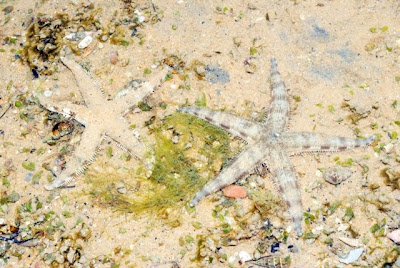Last Saturday, I back on the shores guiding a group of TJC IP students at the sandy lagoon of St John's Island.
The creeper snails were among the first organisms that greeted them on the shore. These snails are EVERYWHERE! This also provided an opportunity to learn that every inch of the shore is alive and that we should be cautious not to trample and hurt the shore.
I also took the opportunity to see how the marine life in the lagoon is thriving thus far. Unfortunately, it does not seem too good.
First of all, the number of Common sea stars (Archaster typicus) seem to be declining with every trip. Not too sure whether it is a day time effect where most stars are hiding under the sand when there is sunlight.
There were some crab sightings such as this very cute Elbow crab (Family Parthenopidae) which I have also seen on my previous St John's trip.
Under a rock, I found this tiny crab which I was initially unsure of its identity.
Flipping it, I soon realized it is actually a juvenile Spoon-pincer crab (Leptodius sp.) based on its claws.
What is this purplish blob doing in the middle of the shore that attracted lots of attention from the students? It is actually a stranded jellyfish!
Among the seagrasses, I was delighted to find two of these tiny seagrass pipefishes.
Here is a closer look. Pipefishes are related to seahorses because they both belong to Family Syngnathidae. 'Syngnathus' means 'fused jaws' in Greek. Seahorses and pipefishes feed on tiny creatures by sucking them up with their tube-like, toothless snouts.
Here is a goby that has colourful body colours, which being pretty is also a delight for the students to look at.
Under the rock, I found this fish that I do not know what it is and have not seen before. Can anyone help me with the identification?
There were a number of fiddler crabs on the muddier parts of the shore, which resembles the mangrove substrates. Most of them escaped to their holes when we approached closer.
I managed to find a few living bivalves with some patterns on its white shells. Not too sure of the identity though.
Here is another species of bivalves that has a foot sticking out from its mantle, allowing the clam to move.
As the tide was not very low, we did not venture into the natural rocky shore. As this was the first shore trip ever for most students, I believe the trip has been an eye opener for them!
What I felt the shore has been missing in terms of marine life will be the Haddon's carpet anemones, soldier crabs, moon crabs, tiny colonies of soft corals and hard corals and tape seagrasses which were present in the past within the lagoon. Not too sure as for the exact reason why life is deteroriating in this shore.
The students also get to visit the Tropical Marine Science Institute (TMSI)! It has been ages since I've went back here after the end of my Final Year Project.
I was stationed to talk about the touch pool and thus also get to have a closer look at the new occupants of this pool, such as a couple of the juvenile Fluted giant clams (Tridacna squamosa).
There were a couple of additions in terms of hard corals such as this rare colony of Moon coral (Diploastrea heliopora).
And also the Horn coral (Hydnophora sp.).
There were also some colonies of the bright Cave corals (Tubastrea sp.) which however did not show their tentacles.
Indeed the touch pool is a hit for the students as they literally get to gently touch some of the organisms living inside such as the sea cucumbers.
During this trip, I also met four fun-loving RJC student guides who are very enthusiastic and interested in marine life. It's always good to see these younger generation more involved in volunteering for nature (as if I'm very old haha).
It was also nice to catch the last of the first series of morning low tides this year, though I have missed most trips due to work. Looking forward to my next trip two weeks ahead!
More photos of the trip here: http://www.flickr.com/photos/koksheng/archives/date-taken/2011/03/26/
Monday, March 28, 2011
St John's shore with TJC students
Subscribe to:
Post Comments (Atom)

























No comments:
Post a Comment